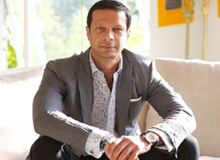A Wharton graduate with a banking job at Merrill Lynch, Robert Tateossian had achieved the model of traditional success for MBA students. But he veered from that path to launch a start-up in high-end fashion, focusing on cufflinks, still a luxury item for most men. Despite the odds and competition, he has managed to build a strong luxury brand. Tateossian spoke with Arabic Knowledge at Wharton about the steps he took to become a name synonymous with elite men's jewelry.

Sign up to stay informed about our latest article releases.